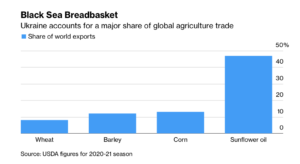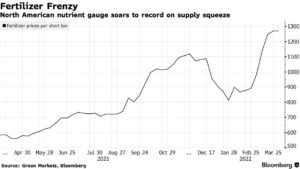The USDA is projecting that the ag trade deficit will shrink in FY2026 even more than previously anticipated. USDA expects the trade deficit to fall from $43.7 billion in FY2025…
Senators Urge CRP Flexibilities; Russian Wheat Exports Continue, While War Worsens Hunger in Africa
Reuters writer Leah Douglas reported yesterday that, “Two senators are joining farm groups and other lawmakers in calling on the U.S. Department of Agriculture to allow farmers to plant conserved acres this spring in response to the Russian invasion of Ukraine.”
Republican Senators Marco Rubio from Florida and Cynthia Lummis from Wyoming sent a letter to Agriculture Secretary Tom Vilsack on March 31 calling on the USDA to allow farmers to plant acres enrolled in the Conservation Reserve Program (CRP) without penalty.
“Senator John Boozman, a Republican from Arkansas and ranking member of the Senate Agriculture Committee, also asked the USDA in March to allow for CRP planting,” the Reuters article said.
Douglas noted that, “The European Union has already moved to allow farmers to plant on fallow land in response to the war in Ukraine and is distributing aid to help them do so.”
Also yesterday, Bloomberg News reported that, “Russia boosted wheat shipments by about 60% in March, despite that being the first month of its invasion of Ukraine.
“The country exported about 1.7 million tons last month, according to consultant ProZerno. That compares with 1.1 million tons sold in March 2021, though those sales were stifled by shifts in government grain-export taxes. The most-recent volume still is only about half of March 2020.”

The Bloomberg article stated that, “Russia and Ukraine together account for about a quarter of global grains trade. Exports from Russia slowed immediately after its February invasion but since have bounced back, according to analysts and data providers. Sales remain tepid out of Ukraine, and that’s keeping global prices for crops such as wheat and sunflower oil at lofty levels and sparking growing worries about food access in major import regions like Middle East and North Africa.”
For additional perspective on Africa, Abdi Latif Dahir reported on the front page of today’s New York Times that, “Across East Africa, below-average rainfall has created some of the driest conditions in four decades, according to the United Nations, leaving more than 13 million people facing severe hunger. Seasonal harvests have hit their lowest in decades, malnourished children are filling hospitals and many families are walking long distances to find help.
“The devastating drought has blanketed most of Somalia, leaving nearly a third of the population hungry. In neighboring Kenya, the drought has left more than three million people short of food and killed more than 1.5 million livestock.
“And in Ethiopia, where a civil war has impeded aid delivery into the northern Tigray region, food insecurity is more widespread than at any time in the last six years. The first food aid to Tigray in three months arrived on Friday.
Now, the war in Ukraine is making the crisis even worse by raising the price of grains, fuel and fertilizer.
Today’s article explained that, “Russia and Ukraine are some of the region’s top suppliers of agricultural commodities such as wheat, soybeans and barley. At least 14 African countries import half of their wheat from Russia and Ukraine, according to the Food and Agriculture Organization. Eritrea depends on them entirely for its wheat imports.”
Dahir noted that, “The war in Ukraine, which is in its second month, is expected to cause further spikes in food costs across the region. The conflict, depending on how long it lasts, could reduce ‘the quantity and quality’ of staples like wheat, said Sean Granville-Ross, the regional director for Africa at Mercy Corps, a nongovernmental organization.”
And Bloomberg writers Katie Linsell, Megan Durisin, and Irina Anghel reported yesterday that, “Russia’s invasion of Ukraine has disrupted the supply of almost half of the world’s sunflower oil exports, forcing companies to turn to less desirable alternatives such as palm oil in products ranging from potato chips to cookies.

“Thousands of items, also including ready meals and even wrapping paper, use sunflower oil. Prices are surging and the ingredient will only become more scarce from the summer as Ukrainian farmers may struggle to grow and export the crop.”
Meanwhile, Bloomberg writers Allison Nicole Smith, Elizabeth Elkin, and Sybilla Gross reported yesterday that, “Prices of fertilizer, crucial for growing most crops, had already been rising worldwide before the invasion amid supply snags and production woes. Now the war has brought new issues. Russia, a big supplier of every major type of crop nutrient, urged domestic fertilizer producers to cut exports in March, stoking fears of shortages of crop inputs that are vital to growers. Russia’s move adds uncertainty to the global market when farmers in Brazil — the world’s largest fertilizer importer — are already having trouble getting nutrients for crops.”

Also on the fertilizer issue, Reuters writer Duncan Miriri reported yesterday that, “Kenya has spent 5.73 billion shillings ($50 million) to buy 114,000 tonnes of fertilisers that it will sell at subsidised prices to cushion farmers against rising costs due to higher prices in world markets, its agriculture minister said.”
And Reuters writers Dominique Patton and Hallie Gu reported yesterday that, “China’s COVID-19 curbs are disrupting the supply of fertiliser to the country’s northeastern bread basket just a month away from spring planting, threatening this year’s corn and soybean crops if not resolved soon.”
“Despite efforts by Beijing to cool prices, China’s wholesale fertiliser index (CFCI) is 40% higher than a year ago,” the Reuters article said.





